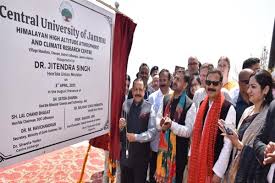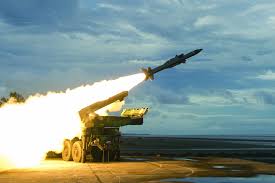Today’s Current Affairs: 10th April 2025 for UPSC IAS exams, State PSC exams, SSC CGL, State SSC, RRB, Railways, Banking Exam & IBPS, etc
Table of Contents
Himalayan High Altitude Atmospheric and Climate Research Centre:

India has inaugurated the Himalayan High Altitude Atmospheric and Climate Research Centre at Nathatop, Jammu & Kashmir, marking a major milestone in global climate science.
- Himalayan High Altitude Atmospheric and Climate Research Centre is located at an altitude of 2,250 meters above sea level in Nathatop, chosen for its clean air and minimal pollution.
- Which makes the center ideal for high-accuracy atmospheric and climate measurements.
- The centre will facilitate cutting-edge studies on cloud formation, aerosol interactions, and weather patterns.
- The inauguration marked the launch of the Indo-Swiss Joint Research Project, ICE-CRUNCH (Ice Nucleating Particles and Cloud Condensation Nuclei Properties in the North-Western Himalayas).
- It focuses on understanding Ice-Nucleating Particles (INPs) and cloud condensation nuclei (tiny suspended particles, either solid/liquid), pivotal to climate modelling and precipitation patterns in the region.
Adenium obesum:

Tiruvallur district in Tamil Nadu is making inroads in cultivating Adenium obesum, more popularly known as ‘desert rose’, a unique flowering plant that has drawn major attention for its novelty as an ornamental houseplant.
- The Adenium obesum, commonly known as the Desert Rose, is a succulent shrub in the dogbane family (Apocynaceae).
- It grows primarily in the desert or dry shrubland biome.
- It is native to the arid regions of Africa and the Arabian Peninsula.
- It is often used as a houseplant for its beautiful flowers and charming, small tree-like shape.
- Desert rose is also used in bonsai (an art of growing and training of a plant to a miniature form).
- It has striking, trumpet-shaped flowers and a unique swollen trunk.
- Its vibrant blooms can range from white to deep red.
- The flowers are highly fragrant and attract a variety of pollinators, including bees and butterflies.
- Special features of the Adenium include its drought tolerance and the ability to store water in its thick trunk, allowing it to survive long periods without rainfall.
- It is a slow-growing plant, only growing about 12 inches per year.
Akash Air Defence Missile System:

India recently offered the indigenous Akash air defence missile system to the UAE.
- Akash Air Defence Missile System is a Short Range Surface to Air Missile System to protect vulnerable areas and points from air attacks.
- It was indigenously designed and developed by India’s Defence Research and Development Organisation (DRDO) and is produced by Hyderabad-based Bharat Dynamics Ltd (BDL).
- The system was inducted into the Indian Air Force in 2014 and in the Indian Army in 2015.
- In 2022, Armenia became the first foreign country to buy this missile system.
- It is 5.8 m long, has a diameter of 350 mm and a wingspan of 1,105mm.
- Range of Operation : 4.5 km to 25 km
- Altitude of Operation : 100 m up to 20 km
- Guidance System : Command Guidance
- Target types: Helicopters, Fighter aircrafts, UAVs etc.
- It can simultaneously engage multiple targets in Group Mode or Autonomous Mode.
- It has built-in Electronic Counter-Counter Measures (ECCM) features.
- It has high immunity against active and passive jamming.
- The entire weapon system has been configured on mobile platforms.
- Open system architecture ensures adaptability to existing and futuristic Air Defence environments.
- The most important element of the Akash SAM system battery is its high-power, multi-function Rajendra phased array radar.
- The 3D passive electronically scanned array Rajendra radar (PESA) can electronically scan and guide the missile towards targets.
- It provides information on the range, azimuth, and height of a flying target.
Arctic Biome:

The 2024 Arctic Report Card by the US NOAA confirms this trend, noting that frequent fires and fossil fuel pollution are turning the Arctic tundra into a carbon source.
- The Arctic tundra is a treeless plain with permafrost within a meter of the soil surface. Summers cause only the top layer to thaw, limiting plant growth and root penetration.
- Despite its rocky, nutrient-poor soil, the tundra holds large amounts of carbon in peat (decayed moss) and humus (organic matter), making it a critical carbon sink.
- The Arctic tundra biome spans 5 million km², covering land north of the Arctic Circle, including parts of Canada, Greenland, Iceland, and Eurasia.
- The climate here is extremely cold, with temperatures from -60°C in winter to 15.5°C in summer. Annual precipitation is low (150–250 mm), mostly in snow and sleet form.
- Vegetation is herbaceous, including grasses, lichens, mosses, and low shrubs like dwarf willows, adapted to cold, wind, and poor soil.
- Animal life includes caribou, polar bears, arctic foxes, musk ox, and migratory birds like loons and snow geese. Insects like mosquitoes flourish in summer due to melting snow.
- Human habitation is limited, mainly to coastal areas, with indigenous communities like the Eskimos living semi-nomadic lives and relying on fishing and hunting.
- Resource extraction has increased in recent decades. Examples include gold mining in Alaska, petroleum in Kenai Peninsula, and iron ore in Labrador, Canada, and Kiruna, Sweden.
- Infrastructure like railways and Arctic ports have enabled the transport of minerals, timber, and furs, especially from Siberia, assisted by modern icebreakers
Rafale-M Jets:

The Cabinet Committee on Security (CCS), chaired by the Prime Minister, approved a ₹63,000-crore deal for procuring 26 Rafale-M fighter jets from France for the Indian Navy.
- Initially, under the MMRCA tender (2007), India planned to acquire 126 jets with technology transfer, which was shelved in 2015.
- A direct deal in 2016 led to 36 Rafale jets for the IAF, delivered between 2019-2022.
- The deal includes 22 single-seater Rafale-M jets for carrier operations and 4 twin-seater trainer variants, which are non-carrier compatible.
- The jets are meant to operate from INS Vikramaditya and INS Vikrant, India’s two operational aircraft carriers.
- Dassault Rafale is a 5 generation, twin-engine, delta-wing, multirole fighter aircraft manufactured by Dassault Aviation.
- Capable of speeds up to Mach 1.8 and a combat radius exceeding 1000 km.
- Designed for air superiority, ground support, reconnaissance and anti-ship missions.
Matter and Anti-matter : New Study

Physicists at CERN’s Large Hadron Collider beauty (LHCb) experiment reported confirmed evidence of Charge-Parity (CP) violation in a class of particles called baryons.
- This is the first statistically significant confirmation of CP violation in baryons, marking a potential breakthrough in understanding the matter-antimatter asymmetry in the universe.
- Matter is anything that has mass and occupies space, composed of atoms and molecules.
- Primary States:
- Solid: Fixed shape and volume.
- Liquid: Fixed volume, no fixed shape.
- Gas: No fixed shape or volume.
- Other States – Plasma, Bose-Einstein Condensate and Fermionic Condensate.
- State Changes: Driven by temperature and pressure, e.g., melting, evaporation, condensation.
- Antimatter consists of particles that are mirror counterparts of matter, with opposite electric charge.
- Electron → Positron, Proton → Antiproton, Neutron → Antineutron
- Both matter and antimatter were created during the Big Bang in equal amounts.
- When matter and antimatter collide, they annihilate each other, producing gamma rays.
- Sources: Natural: Cosmic rays and radioactive decay.
- Particle accelerators like the LHC simulate conditions similar to the Big Bang, producing antiparticles.
De-Extinction of Dire Wolf:
A U.S.-based biotech firm, Colossal Biosciences, claimed the birth of three genetically engineered wolf pups, marking the first-ever attempt at “de-extinction” of the extinct dire wolf species after 12,500 years.De-extinction refers to the process of reviving extinct species using advanced biotechnological methods such as:
- Gene editing (e.g., CRISPR-Cas9).
- Ancient DNA sequencing and reconstruction.
- Cloning and synthetic biology.
Palna Scheme:
The 7th edition of Poshan Pakhwada began on April, with a spotlight on early childhood nutrition, and the government’s Palna Scheme is being promoted as a key childcare intervention under Mission Shakti.Palna is a centrally sponsored scheme that provides quality crèche services for children aged 6 months to 6 years, especially for working mothers in urban and rural India.Implemented by the Ministry of Women and Child Development (MoWCD).
One State, One RRB Policy:
The Ministry of Finance has notified the amalgamation of 26 Regional Rural Banks (RRBs) across 10 states and 1 union territory under the “One State, One RRB” policy, effective from May 1, 2025, reducing the total number of RRBs to 28.A reform initiative of the Department of Financial Services aimed at consolidating RRBs within a state into a single entity.The consolidation process thus was initiated in the year 2005 as an off-shoot of Dr Vyas Committee Recommendations.
World’s first 3D-printed train station in Arida city:
Japan’s West Japan Railway Company unveiled the world’s first 3D-printed train station in Arida city. The new Hatsushima station was built in under six hours, showcasing cutting-edge construction innovation.3D Printing or Additive Manufacturing is a technique of creating three-dimensional objects by layering materials based on a digital model.Unlike traditional manufacturing (subtractive), it adds material layer by layer, reducing waste and allowing intricate designs.
India Skills Accelerator Initiative:
The Ministry of Skill Development and Entrepreneurship (MSDE) has partnered with the World Economic Forum (WEF) to launch the India Skills Accelerator.A national-level public-private platform focused on future-ready skilling and inclusive workforce development.Aims to be a systemic change enabler by improving coordination among stakeholders, updating policy frameworks, and creating scalable skilling pathways.The Accelerator aims to catalyze change across three critical levels:By improving awareness and shifting mindsets around future skills needs,Increasing collaboration and knowledge sharing among stakeholders, andCommitting to upgrade institutional structures and policy frameworks to support a more adaptive and responsive skilling ecosystem.




